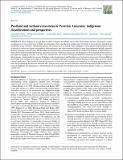Files in this item
Peatland and wetland ecosystems in Peruvian Amazonia : indigenous classifications and perspectives
Item metadata
| dc.contributor.author | Schulz, Christopher | |
| dc.contributor.author | Martín Brañas, Manuel | |
| dc.contributor.author | Núñez Pérez, Cecilia | |
| dc.contributor.author | Del Aguila Villacorta, Margarita | |
| dc.contributor.author | Laurie, Nina | |
| dc.contributor.author | Lawson, Ian T. | |
| dc.contributor.author | Roucoux, Katherine H. | |
| dc.date.accessioned | 2019-05-07T10:30:01Z | |
| dc.date.available | 2019-05-07T10:30:01Z | |
| dc.date.issued | 2019-04-30 | |
| dc.identifier | 258519441 | |
| dc.identifier | 9498255b-dd65-4529-b25f-6d6f7fdaea5e | |
| dc.identifier | 85070815066 | |
| dc.identifier | 000482712400020 | |
| dc.identifier.citation | Schulz , C , Martín Brañas , M , Núñez Pérez , C , Del Aguila Villacorta , M , Laurie , N , Lawson , I T & Roucoux , K H 2019 , ' Peatland and wetland ecosystems in Peruvian Amazonia : indigenous classifications and perspectives ' , Ecology and Society , vol. 24 , no. 2 , 12 . https://doi.org/10.5751/ES-10886-240212 | en |
| dc.identifier.issn | 1708-3087 | |
| dc.identifier.other | ORCID: /0000-0003-0081-1404/work/64361332 | |
| dc.identifier.other | ORCID: /0000-0001-6757-7267/work/64698061 | |
| dc.identifier.other | ORCID: /0000-0002-3547-2425/work/75996909 | |
| dc.identifier.uri | https://hdl.handle.net/10023/17653 | |
| dc.description | Authors gratefully acknowledge funding from the Scottish Funding Council, the Natural Environment Research Council (NE/R000751/1), and the University of St Andrews. | en |
| dc.description.abstract | Many indigenous people hold detailed ecological knowledge about their environment and have developed complex classifications of ecosystem types in their own languages. These classification systems may be based on characteristics including the availability of key resources, salient plant species, and cultural factors, among others. Indigenous environmental knowledge has been of interest to (ethno-)ecologists, geographers, anthropologists, and other scientists looking to learn from indigenous people, especially in newly emerging research topics. We identified and interpreted an ecosystem classification system of the Urarina, a small indigenous nation based in the Chambira River basin, a peatland-rich area of Peruvian Amazonia. Our findings, based on semistructured interviews, participatory mapping exercises, and site visits, indicate that the Urarina distinguish between ecosystems according to vegetation physiognomy, certain (palm) tree species, hydrology, and soil appearance, and that their use of natural resources varies between different ecosystems. Two Urarina ecosystems, jiiri and alaka, are almost certainly associated with the presence of peat soils and are of special cultural significance. The Urarina ecosystem classification system thus offers insights and inspiration for ecologists studying peatlands and other wetlands in the Peruvian Amazon who, thus far, have mostly focused on floristic and structural analyses only. Not least, our research highlights the importance of the peatlands for local people, beyond their role for the global climate system as a substantial carbon store. | |
| dc.format.extent | 16 | |
| dc.format.extent | 7390823 | |
| dc.language.iso | eng | |
| dc.relation.ispartof | Ecology and Society | en |
| dc.subject | Amazon | en |
| dc.subject | Ecosystem classification | en |
| dc.subject | Indigenous knowledge | en |
| dc.subject | Peru | en |
| dc.subject | Tropical peatland | en |
| dc.subject | Urarina | en |
| dc.subject | G Geography (General) | en |
| dc.subject | GN Anthropology | en |
| dc.subject | NDAS | en |
| dc.subject | SDG 13 - Climate Action | en |
| dc.subject.lcc | G1 | en |
| dc.subject.lcc | GN | en |
| dc.title | Peatland and wetland ecosystems in Peruvian Amazonia : indigenous classifications and perspectives | en |
| dc.type | Journal article | en |
| dc.contributor.sponsor | NERC | en |
| dc.contributor.sponsor | Scottish Funding Council | en |
| dc.contributor.institution | University of St Andrews. School of Geography & Sustainable Development | en |
| dc.contributor.institution | University of St Andrews. Centre for Research into Equality, Diversity & Inclusion | en |
| dc.contributor.institution | University of St Andrews. Bell-Edwards Geographic Data Institute | en |
| dc.identifier.doi | 10.5751/ES-10886-240212 | |
| dc.description.status | Peer reviewed | en |
| dc.identifier.grantnumber | NE/R000751/1 | en |
| dc.identifier.grantnumber | SFC/AN/10/2018 | en |
This item appears in the following Collection(s)
Items in the St Andrews Research Repository are protected by copyright, with all rights reserved, unless otherwise indicated.

